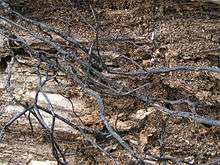Mycelial cord

Mycelial cords are linear aggregations of parallel-oriented hyphae. The mature cords are composed of wide, empty vessel hyphae surrounded by narrower sheathing hyphae. Cords may look similar to plant roots, and also frequently have similar functions; hence they are also called rhizomorphs (literally, "root-forms").
Mycelial cords are capable of conducting nutrients over long distances. For instance, they can transfer nutrients to a developing fruiting body, or enable wood-rotting fungi to grow through soil from an established food base in search of new food sources. For parasitic fungi, they can help spread infection by growing from established clusters to uninfected parts. The cords of some wood-rotting fungi (like Serpula lacrymans) may be capable of penetrating masonry.
The mechanism of the cord formation is not yet precisely understood. Mathematical models suggest that some fields or gradients of signalling chemicals, parallel to the cord axis, may be involved.
Rhizomorphs can grow up to 9 m (30 ft) in length and 5 mm (0.20 in) in diameter.